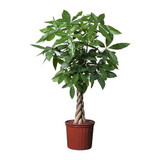



Tree Root Barrier Range of Sizes on sale - Control The Roots And Protects Foundations
Our Tree Root Barrier:
|
|||||||||||||
| What length of tree root barrier do I need? The root barrier can be used around a tree or trees or in front of a foundation to prevent damage to it - a garden wall, pavement, pipes etc. If you use a barrier around the tree, try to provide the tree as much space as it may need in the future, to keep it growing well- so if it is going to be a large tree allow extra space (for park trees provide about 4m diameter bed around it). Small garden trees will need about 1.5m diameter and most trees will need about 2m diameter . An extra 0.5m is needed for overlapping both ends. |
|||||||||||||
When using tree root barrier around a single tree:
|
|||||||||||||
|
Root barrier can save a lot of money. Root barrier is an essential product that prevents damage to foundations such as pavement walls, water systems and drainage systems. It also prevents competition between plants for water and nutrients. It is recommended to install when planting or after planting, and can be used with bamboo, palm trees and any other big trees. This product can also be used as walls to drainage systems.
|
|||||||||||||
|
Roots in plumbing lines Trees Roots frequently clog plumbing lines. The problem tree may be quite a distance away, as some trees are known for their invasive properties. A root barrier can reduce the problem if used properly. |
|||||||||||||
|
Root barrier to protect a patio
Question:
Answer: A barrier may be placed into the soil to prevent the extension of roots under the patio. This barrier may be a solid substance (metal, plastic, or concrete). This will require digging a trench and placing the barrier material vertically into the trench to block the growth of roots. Perhaps the easiest and cheapest material to use for this is a thick plastic material that may be purchased in sheets. However, with this or other material, the overlap between sheets of material becomes the weak point in the barrier. Often the roots will find their way past the barrier, and in time these roots may cause the damage you wish to prevent. Since you are planning to create a root barrier at the time you plant the new tree, you will not harm the tree when installing the root barrier. However, if any of the root control measures mentioned is used near established trees, care must be taken not to dig trenches too near the tree. Digging too closely to the tree can result in damage to major roots. This will result in damage or death of the tree. When trenching near established trees, maintain a sufficient distance. The root barrier will also be effective in protecting pavement from established trees, if the trees are not injured during the installation process.’’ Written by Curtis W. Smith, Ph.D, an Extension Horticulture Specialist with New Mexico State University |
|||||||||||||
|
Roots from a neighbour's tree or your trees may invade your property and compete with your plants for nutrients. Some trees,such as willow and birch, can be aggressive in seeking water and they can cause dry ground and mineral deprivation around them by removing water and nutrients needed for survival. Despite numerous tries, you may not be able to grow anything in these areas. Anchoring roots are directed downward effectively extending the trunk of the tree. At the base of the barrier they spread out laterally, thus minimising damage to hard landscaping surfaces.
|
|||||||||||||
|
What is a good tree root barrier and when should we use it? |













